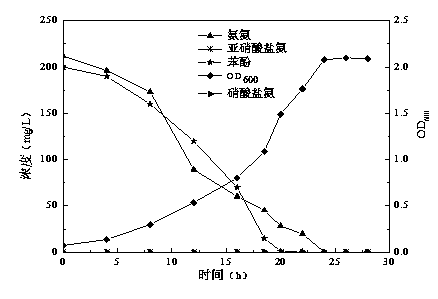Acinetobacter sp. and preparation method of acinetobacter sp. agent
A technology of Acinetobacter and inoculum, applied in the field of preparation of Acinetobacter and inoculum, can solve the problem of low ammonia nitrogen degradation efficiency, and achieve the effects of high degradation efficiency, strong environmental adaptability, and easy large-scale production
- Summary
- Abstract
- Description
- Claims
- Application Information
AI Technical Summary
Problems solved by technology
Method used
Image
Examples
Embodiment 1
[0017] Embodiment 1, Isolation and purification of strains
[0018] (1) Source of the strain
[0019] The bacteria source was collected from the activated sludge of the wastewater biological treatment system of Wuhan Iron and Steel Coking Company.
[0020] (2) Isolation and purification of strains
[0021] The activated sludge collected is mixed, and 2 mL is inoculated in 100 mL of sterilized LB medium, the composition of the LB medium is: peptone is 1 wt%, sodium chloride is 1 wt%, yeast extract is 0.5 wt%; then cultured on a constant temperature shaker at 30°C and 150r / min for 15 h; then took 5 mL of the culture solution and transferred it to the sterilized nitrification medium, transferred 4 times, and gradually increased during the transfer process. The concentration of ammonium sulfate is as follows: 300mg / L, 600mg / L, 900mg / L, 1200mg / L. During the acclimatization period, phenol was added to the nitrification medium at the same time so that its final concentration was...
Embodiment 2
[0022] Embodiment 2, Identification of strains
[0023] (1) Morphological observation of the strain
[0024] Strain Y 3 After gradient dilution of the culture solution, spread it evenly on the top of the solid nitration medium, place it in a 30°C incubator for 22 hours, and observe the morphology. The results are as follows: figure 1 shown. Depend on figure 1 It can be seen that the bacterial colony is milky white, round, with a raised middle, smooth and moist surface, and neat edges. Pick a few colonies, after Gram staining, observe under the oil lens of an optical microscope, the results are as follows: figure 2 As shown, it can be clearly seen that the individual bacteria of the strain with the preservation number CCTCC NO: M2013445 are short rod-shaped, red in color, and are Gram-negative bacteria.
[0025] (2) 16S rDNA identification of the strain
[0026] Extract strain Y with DNA extraction kit 3 The genomic DNA was then cloned and sequenced for the 16S rDNA...
Embodiment 3
[0027] Embodiment 3, Acinetobacter ( Acinetobacter sp.) Y 3 Preparation of bacteria
[0028] Prepare 3L of nitrification medium, add it to a 5L fermenter, and add 1.5mL of Dow antifoaming agent, then place it in a high-pressure steam sterilizer, and sterilize it at 121°C for 25 minutes, and the culture to be sterilized After cooling the base, the Acinetobacter
[0029] ( Acinetobacter sp.) Y 3 Inoculate 3 vol% into the nitrifying medium, ferment at 30°C, 150 r / min and 0.5 (V / V min) aeration, stop fermentation after 24 hours, and add 25 vol% glycerol as a protective agent , for cryopreservation.
PUM
 Login to View More
Login to View More Abstract
Description
Claims
Application Information
 Login to View More
Login to View More - R&D
- Intellectual Property
- Life Sciences
- Materials
- Tech Scout
- Unparalleled Data Quality
- Higher Quality Content
- 60% Fewer Hallucinations
Browse by: Latest US Patents, China's latest patents, Technical Efficacy Thesaurus, Application Domain, Technology Topic, Popular Technical Reports.
© 2025 PatSnap. All rights reserved.Legal|Privacy policy|Modern Slavery Act Transparency Statement|Sitemap|About US| Contact US: help@patsnap.com



